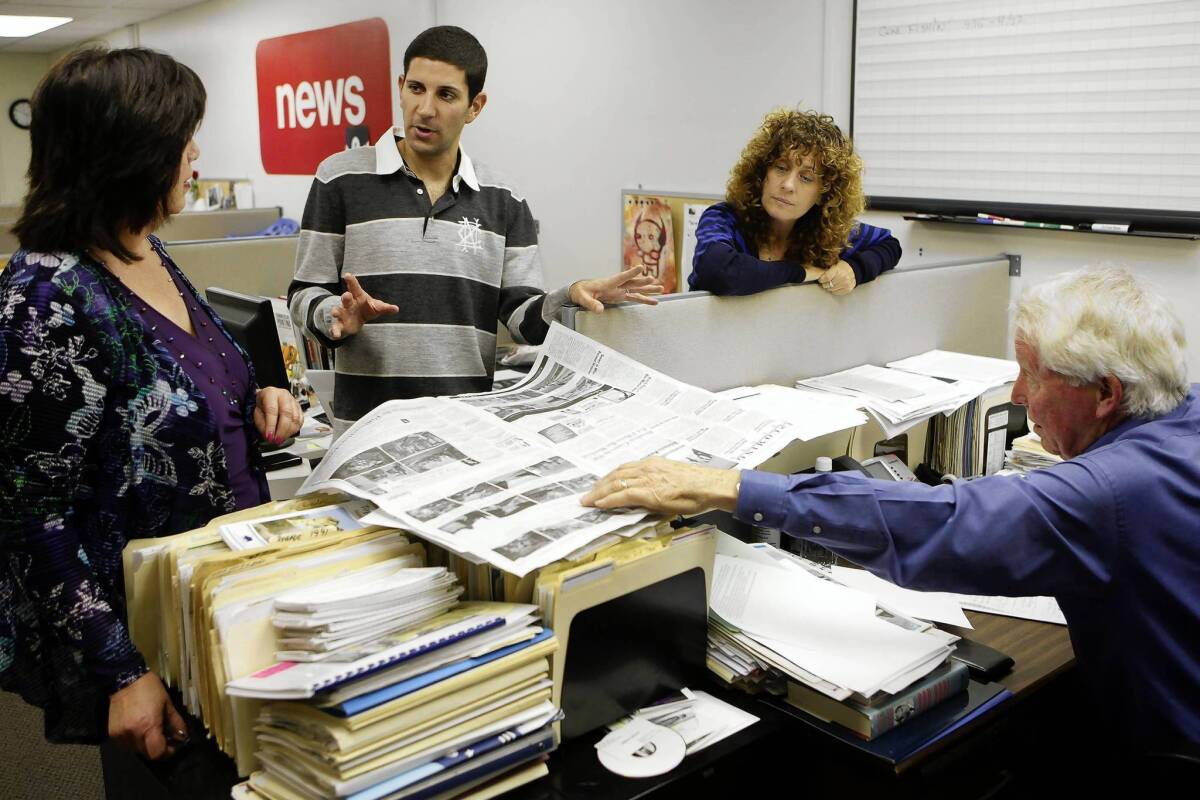Pacific Palisades newspaper junkie buys his own paper

- Share via
At 6:45 a.m., Alan Smolinisky pads out to his driveway in a hillside cul-de-sac just west of the Getty Villa.
He wears black-and-white-checked flannel pajama bottoms and a pristinely white T-shirt that glows like a beacon in the muted light. In one arm, he carries 15-month-old Charlie, named for billionaire investor Charles Munger.
Bending carefully toward the concrete apron, Smolinisky lets Charlie scoop up three newspapers stuffed in plastic bags.
As Charlie sucks on a bottle in the kitchen, Smolinisky unwraps the Los Angeles Times, the Wall Street Journal and the Financial Times, separating sections into carefully considered piles — news, features, markets coverage. By day’s end, he will have spent five hours reading them cover to cover.
Smolinisky, 33, is a newspaper junkie. He abides by Munger’s philosophy that high achievers in the financial world tend to be voracious readers.
“I love knowing everything going on everywhere in the world,” said Smolinisky, a real estate entrepreneur who keeps a peacock blue Bentley and a red Ferrari in his garage. Late last year, he satisfied a decade-long dream, paying seven figures for the Palisadian-Post. The weekly has chronicled life in Pacific Palisades since 1928 and has been losing money. Smolinisky aims to turn it around.
“Pacific Palisades is my favorite place on Earth, and the Palisadian-Post is my favorite newspaper,” he said. “I have a moral obligation to make sure this newspaper arrives every Thursday for as long as I live.”
::
At a time when his peers have mostly traded paper for pixels, Smolinisky doesn’t own an iPad or a Kindle. He’s not much for social media and says he has never used Facebook or Twitter. So it seemed fitting that he chose to buy this decidedly low-tech, old-school paper.
The broadsheet has endeared itself to residents by recording quotidian happenings — births, marriages and deaths, with a panoply of soccer games, high school graduations and Fourth of July parades in between. The paper covers each year’s first Palisadian baby, the Mr. and Miss Palisades contest, young residents’ accomplishments and 50th wedding anniversaries.
Bill Bruns, managing editor since 1993, likes to joke that, if a resident of Brentwood won a Nobel Prize, the paper would not cover the story. But if the person lived in the Palisades the news would land on the front page.
When Smolinisky and his friends were tykes, the Pali-Post ran photos of their T-ball and soccer games. When he was a teen, it carried stories about A&A; Productions, a company he co-founded that put on dances in the Palisades.
“All the other papers are so serious and scary,” he said. “The Palisadian-Post was never like that. It always had this hyper-local, fun attitude of ‘we are the luckiest people on Earth to live in such an amazing, crime-free community.’ ”
What other publication, he mused, would write about where the Department of Water and Power would put its new electrical substation? Or about the colorful gingerbread-themed house on Sunset Boulevard? Or the house across the street from the gingerbread-themed house, the one where the Iranian immigrant erected dozens of Iranian and U.S. flags and a banner reading “Long Live Iran and United States Peace.”
Page 2 each week features “Your Two Cents Worth,” a column of brief, unsigned questions and opinions from readers. After hearing from readers and editors how popular the sound-off column was, Smolinisky allotted more space.
Donna Vaccarino, an architect, heard Smolinisky speak at a community meeting and was impressed by his pride in owning the paper. “We all want to help him make it a success,” she said.
Smolinisky bought the publication and its office building on Via de la Paz. The deal included the Post’s money-losing commercial printing business, which he closed. He has told the staff he wants to make the paper profitable so that he can restore full-time status to 16 employees, including seven in the newsroom, who have endured years of shortened hours and pay. (An eighth newsroom employee, the copy editor, volunteers her time.)
Smolinisky has learned some quick lessons in newspaper economics. An equipment broker inspected the 37-foot-long Goss printing press in the concrete-lined back shop. It was valued 30 years ago at nearly $400,000. The broker named a price: $15,000.
The fledgling newspaperman was elated at first, having feared that the bulky machine had no value. Then the realization dawned. That was the price he’d have to pay somebody to haul the press away. For now, it remains in place.
Smolinisky finds he doesn’t get much done when he’s in the newsroom. “I sort of worship the writers and just like to watch them and listen to what they are up to,” he said.
He recently high-fived the staff for posting updates of a rush-hour street closure in Santa Monica Canyon that had police officers rerouting residents’ cars. “We have reporters on the scene!” he said in an email. “I am having way too much fun!!! How cool is this???”
::
Smolinisky was raised by immigrant parents from Argentina who still live in the Palisades. By his own account, he had a smart mouth. One private Palisades school kicked him out for “disruptive behavior.” He graduated from Pali High.
While a music student at USC, Smolinisky joined forces with his landlord, who had a small student housing business. The company began constructing upscale student apartments around USC and later UC Santa Barbara. The business grew and in 2009 they sold it.
With some of the proceeds, the partners bought several commercial properties. Smolinisky invested much of the rest of his proceeds and personally manages every penny. Tips gleaned from the dozen daily, weekly and bimonthly publications he reads have led to lucrative investments, he said.
He reads the front section of The Times each morning as he walks Molly Jolie-Pitt, a Rhodesian ridgeback-boxer mix. A woman stopped him one morning to say she had seen him walking and reading for years. After learning that he had bought the Pali-Post, she said: “Now it all makes sense.”
In a Dec. 6 letter to readers titled “Why I’ve Bought the Palisadian-Post,” Smolinisky shared details of his courtship of Caroline Sukits, a Hoosier native he met briefly at USC and encountered again seven years later at a party. By the summer of 2008, they were considering marriage.
Smolinisky was adamant about one thing. For him, there was only one place to live, and that was the ‘sades, local shorthand for the affluent enclave in the western reaches of Los Angeles that has been home to the likes of Kobe Bryant, Ben Affleck and Jennifer Garner, and Ronald Reagan.
The couple married in July 2010, had Charlie in September 2011 and are expecting a girl in May. Come summer, they plan to move into a traditional, white-painted brick mansion they’re building on Chautauqua Boulevard in the community’s Huntington neighborhood.
Smolinisky dislikes the idea of dynastic wealth and agrees with Berkshire Hathaway Chairman Warren Buffett that rich folks should give away at least half of their money.
Framed in Smolinisky’s home office is a hand-scribed note from Buffett: “You are living a life that I admire.” It was his response to Smolinisky’s news that he and Caroline had set up a living trust earmarking 90% of their wealth for charities upon their deaths. They donate regularly to UCLA, Homeboy Industries and the American Civil Liberties Union Foundation of Southern California, on whose board Smolinisky has served for a decade.
His goal is to be a billionaire, like his idols Buffett and Munger.
Smolinisky knows the Palisadian-Post won’t help him reach that goal. Still, he is determined to get the newspaper before the eyes of more readers; 4,000 households in the Palisades subscribe, about 40% penetration, for $49 a year.
He’s talking up his newspaper all over town. At one gathering, a man asked if he could subscribe and pulled out a $50 bill. Smolinisky said yes — and gave him $1 change.
More to Read
Sign up for Essential California
The most important California stories and recommendations in your inbox every morning.
You may occasionally receive promotional content from the Los Angeles Times.














